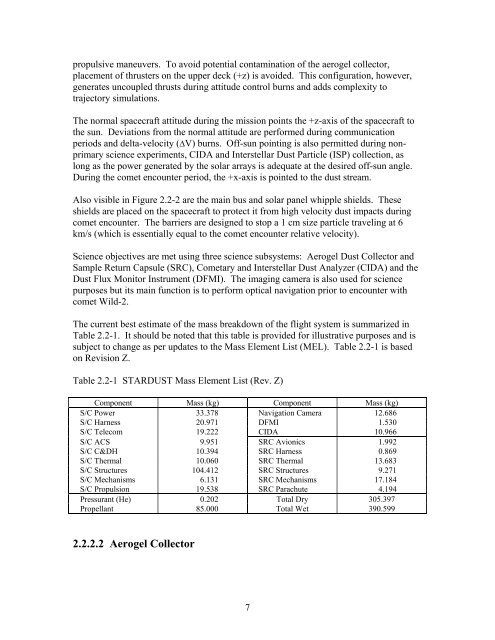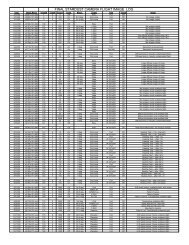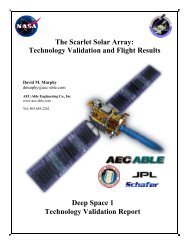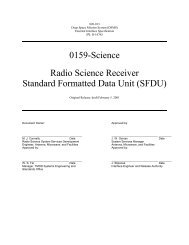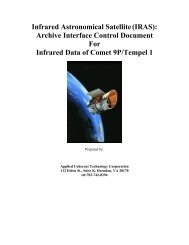MISSION PLAN - PDS Small Bodies Node
MISSION PLAN - PDS Small Bodies Node
MISSION PLAN - PDS Small Bodies Node
You also want an ePaper? Increase the reach of your titles
YUMPU automatically turns print PDFs into web optimized ePapers that Google loves.
propulsive maneuvers. To avoid potential contamination of the aerogel collector,<br />
placement of thrusters on the upper deck (+z) is avoided. This configuration, however,<br />
generates uncoupled thrusts during attitude control burns and adds complexity to<br />
trajectory simulations.<br />
The normal spacecraft attitude during the mission points the +z-axis of the spacecraft to<br />
the sun. Deviations from the normal attitude are performed during communication<br />
periods and delta-velocity (∆V) burns. Off-sun pointing is also permitted during nonprimary<br />
science experiments, CIDA and Interstellar Dust Particle (ISP) collection, as<br />
long as the power generated by the solar arrays is adequate at the desired off-sun angle.<br />
During the comet encounter period, the +x-axis is pointed to the dust stream.<br />
Also visible in Figure 2.2-2 are the main bus and solar panel whipple shields. These<br />
shields are placed on the spacecraft to protect it from high velocity dust impacts during<br />
comet encounter. The barriers are designed to stop a 1 cm size particle traveling at 6<br />
km/s (which is essentially equal to the comet encounter relative velocity).<br />
Science objectives are met using three science subsystems: Aerogel Dust Collector and<br />
Sample Return Capsule (SRC), Cometary and Interstellar Dust Analyzer (CIDA) and the<br />
Dust Flux Monitor Instrument (DFMI). The imaging camera is also used for science<br />
purposes but its main function is to perform optical navigation prior to encounter with<br />
comet Wild-2.<br />
The current best estimate of the mass breakdown of the flight system is summarized in<br />
Table 2.2-1. It should be noted that this table is provided for illustrative purposes and is<br />
subject to change as per updates to the Mass Element List (MEL). Table 2.2-1 is based<br />
on Revision Z.<br />
Table 2.2-1 STARDUST Mass Element List (Rev. Z)<br />
Component Mass (kg) Component Mass (kg)<br />
S/C Power 33.378 Navigation Camera 12.686<br />
S/C Harness 20.971 DFMI 1.530<br />
S/C Telecom 19.222 CIDA 10.966<br />
S/C ACS 9.951 SRC Avionics 1.992<br />
S/C C&DH 10.394 SRC Harness 0.869<br />
S/C Thermal 10.060 SRC Thermal 13.683<br />
S/C Structures 104.412 SRC Structures 9.271<br />
S/C Mechanisms 6.131 SRC Mechanisms 17.184<br />
S/C Propulsion 19.538 SRC Parachute 4.194<br />
Pressurant (He) 0.202 Total Dry 305.397<br />
Propellant 85.000 Total Wet 390.599<br />
2.2.2.2 Aerogel Collector<br />
7


